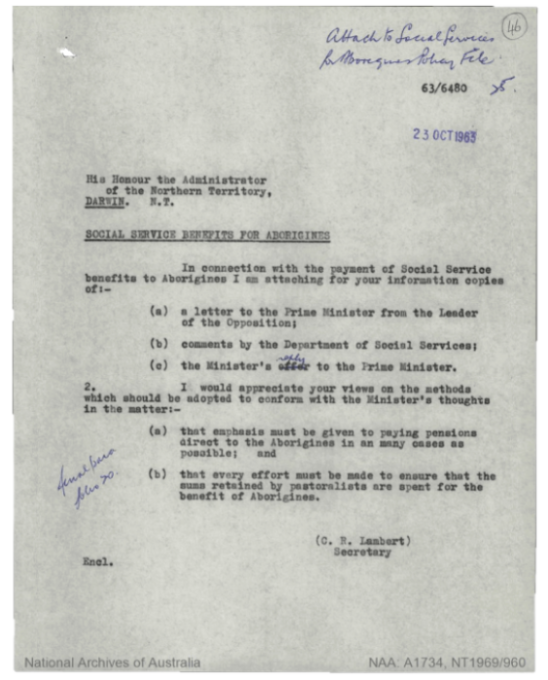
Opposition calls for end to indirect payments for Aboriginal people
In letters sent in the early 1960s, the opposition questioned the government about the practice of missions, stations and reserves using Aboriginal people’s payments on their behalf. In their response, the government defended the practice.
Frankly, I think we have just got to insist on all the implication[s] of citizenship and then add generosity.
| Attachment | Size |
|---|---|
| calwell-menzies-letters.pdf | 1.78 MB |
| Attachment | Size |
|---|---|
| calwell-menzies-letters-plaintext.docx | 54.81 KB |
In September 1963, Opposition Leader Arthur Calwell of the Labor Party wrote to Prime Minister Robert Menzies about the practice of paying Aboriginal people their government payments indirectly. Menzies and his officials responded defensively.
At the time, it was policy for Aboriginal people living on missions, stations and settlements not to get their full payment directly. Instead, the institutions collected the payments and used most of the money to cover living costs. They would then pass on a small amount in ‘pocket money’.
Calwell’s letter
In his letter to Menzies, Calwell said an ‘informant’ from the NT Legislative Council had let him know about this practice. He wrote that the informant said it caused ‘the greatest racket ever’. He also reported that government officials did not ‘check and see how this money is used (or abused).’
Calwell argued the government should reduce the use of this practice and pay people directly. He also said there should be more welfare officers to help Aboriginal people. He concludes by saying the government should ‘insist on all the implication[s] of citizenship and then add generosity’.
Government's response
In his response, Menzies agreed with Calwell’s recommendations ‘in principle’, but said the policy of indirect payments had worked well so far. He said Aboriginal people would get direct payments once ‘sufficiently advanced’.
Director-General of the Department of Social Services, HJ Goodes, said direct payments were the normal case and that if institutions collected some it was for ‘maintenance’. He said state and territory officials regularly inspected properties. He also said Calwell’s ideas wouldn’t be in the best interest of Aboriginal people because they didn’t account for people who weren’t ‘advanced as to be able to manage their own affairs’.
Minister for Territories, Paul Hasluck, explained the situation in more detail and said the practice was only temporary. He said it would be best for the government to make direct payments in as many cases as possible.
The ‘temporary’ practice continued for many years after these letters. State and territory authorities began more regular inspections of missions, stations and reserves who were receiving Aboriginal people’s payments. The issue of indirect payments was discussed again at a government meeting in 1965.
These documents were copied and kept on a file by the Department of the Interior. The file was later transferred to the National Archives of Australia, which holds it as part of the national archival collection.
You can access the file through RecordSearch. Go to pages 192–198 for Calwell’s letter and pages 188–189 for Menzies’s reply.
Citation
National Archives of Australia: Department of the Interior; A1734, Correspondence files, 1933–1980; NT1969/960, Social Service Benefits for Aborigines – Northern Territory, 1964–66.
